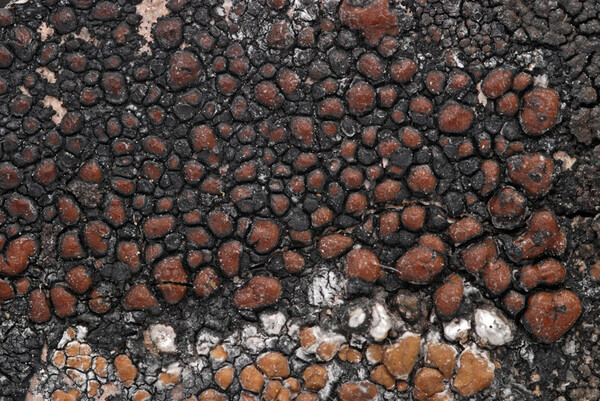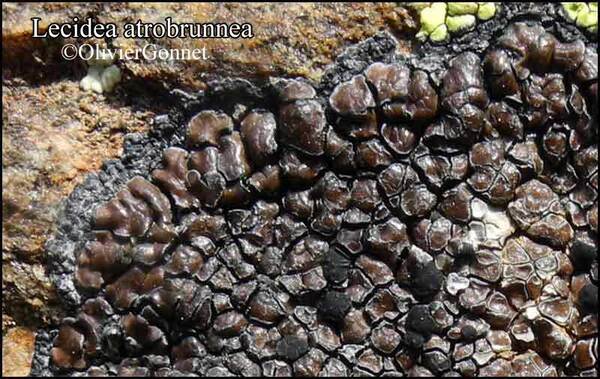Lecidea atrobrunnea (DC.) Schaer. subsp. atrobrunnea
Lich. Helv. Spicil., sect. 3: 134, 1828. Basionym: Rhizocarpon atrobrunneum DC. in Lamarck & de Candolle - Fl. Franç., éd. 3, 2: 367, 1805.
Synonyms: Lecidea funckii Flot.; Lecidea protecta H. Magn.; Lecidea pseudassimilis Hertel; Lecidella atrobrunnea (DC.) Körb.; Psora atrobrunnea (DC.) A. Massal.; Sporastatia funckii (Flot.) Dalla Torre & Sarnth.
Distribution: N - Ven (TSB 11714), TAA (Hertel & Leuckert 2008, Nascimbene & al. 2022), Lomb (Hertel & Leuckert 2008, Hertel & Schuhwerk 2010), Piem (Isocrono & al. 2003, 2004, Morisi 2005, Isocrono & Piervittori 2008, Hertel & Leuckert 2008, Hertel & Schuhwerk 2010, Favero-Longo & al. 2013, Watson 2014), VA (Piervittori & al. 1998, 2004, Piervittori & Isocrono 1999, Piervittori & al. 2001, Favero-Longo & al. 2005b, Isocrono & al. 2008, Favero-Longo & Piervittori 2009, Matteucci & al. 2013b, 2015c), Lig (TSB 33431). C - Sar (Rizzi & al. 2011). S - Bas (Hertel & Leuckert 2008).
Description: Thallus crustose, episubstratic, 0.5-2.5 mm thick, areolate to almost squamulose, of flat to strongly convex, up to 3 mm wide, yellow-brown, copper-brown or dark reddish brown, often shiny areoles with or without a thin, whitish to blackish edge; prothallus absent or usually conspicuous, dark. Medulla white, I+ intensely blue-violet, Apothecia lecideine, black, 0.5-1.5(-2.5) mm across, often clustered, slightly constricted base, with a flat to convex, rarely bluish-pruinose disc, and a persistent, raised, often slightly wavy proper margin. Proper exciple of parallel-radiating, 3-7 µm thick hyphae, blue- to green-black in outer part, colourless or very pale brown within, 25-150 µm wide laterally; epithecium bright green, bluish-green, or olive-green; hymenium colourless to very pale greenish in upper part, 34-62 µm high, I+ blue; paraphyses coherent, usually simple or shortly branched in upper part, rarely anastomosing, 1.5-2.5 µm thick at mid-level, the apical cells clavate, 3-5 µm wide; hypothecium colourless to pale brown, I+ blue. Asci 8-spored, narrowly clavate, thick-walled, with a K/I+ pale blue tholus and a strongly amyloid, thin apical cushion, surrounded by a I+ blue outer layer, Lecidea-type. Ascospores 1-celled, hyaline, ellipsoid-oblong, with rounded ends, (5-)6.7-11.7(-13) x 3-7 µm. Pycnidia immersed with a usually irregular to graphidioid ostiolar region. Conidia bacilliform, (5.5-)7.2-11.1(-26) x 0.8-1.4 µm. Photobiont chlorococcoid. Spot tests: thallus and medulla K-, C-, KC-, P-. Chemistry: confluentic acid and/or 2'-O-methylperlatolic acid.Note: a bipolar, arctic-alpine to boreal-montane species of acid siliceous rocks in exposed situations, with optimum near and above treeline; common only in the Alps. The species is chemically variable, and several chemotypes were distinguished. For further details see Hertel & Leuckert (2008).
Growth form: Crustose
Substrata: rocks
Photobiont: green algae other than Trentepohlia
Reproductive strategy: mainly sexual
paras Bellemerea spp. and Lecidea silacea when young
Species of metal-rich rocks
Commonnes-rarity: (info)
Alpine belt: extremely common
Subalpine belt: rather common
Oromediterranean belt: very rare
Montane belt: absent
Submediterranean belt: absent
Padanian area: absent
Humid submediterranean belt: absent
Humid mediterranean belt: absent
Dry mediterranean belt: absent

Predictive model
Herbarium samples
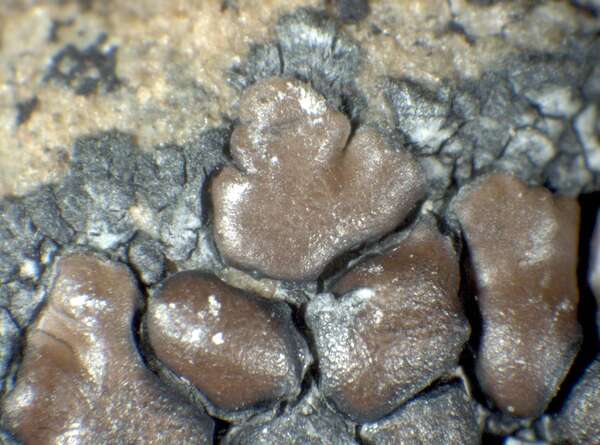

P.L. Nimis; Owner: Department of Life Sciences, University of Trieste
Herbarium: TSB (35206)
2002/07/09
marginal areolae and prothallus


P.L. Nimis; Owner: Department of Life Sciences, University of Trieste
Herbarium: TSB (11714)
2001/11/26
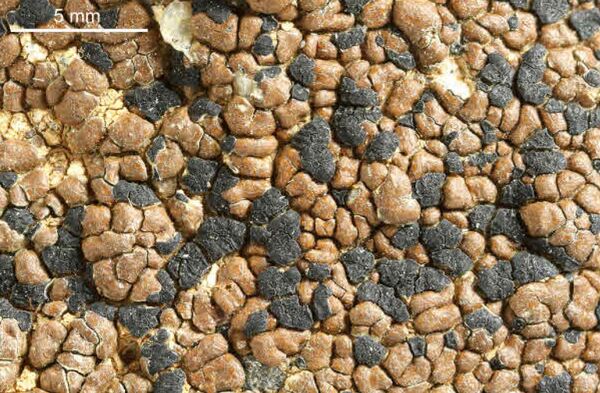

Felix Schumm – CC BY-SA 4.0
[10126], Südspanien, Prov. Granada: verbreitet auf glattem, schwach geneigtem, licht- und windoffenem Urgesteinsschutt im Omphalodinion rubinae (Frey) Follm., 3100 m, NW-SW, pH 6.5, Plattenschüsse am Nordwestaufschwung des Mulhacén in der Sierra Nevada. Leg. G. Follmann 07.1975, det. Poelt 09.1975.


Felix Schumm – CC BY-SA 4.0
[10126], Südspanien, Prov. Granada: verbreitet auf glattem, schwach geneigtem, licht- und windoffenem Urgesteinsschutt im Omphalodinion rubinae (Frey) Follm., 3100 m, NW-SW, pH 6.5, Plattenschüsse am Nordwestaufschwung des Mulhacén in der Sierra Nevada. Leg. G. Follmann 07.1975, det. Poelt 09.1975.
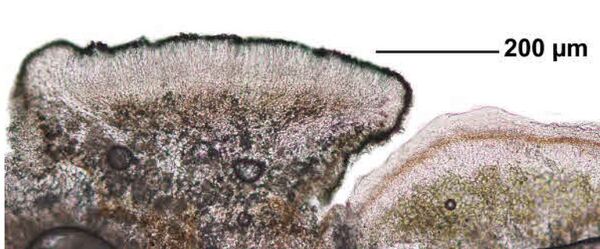

Felix Schumm – CC BY-SA 4.0
[10126], Südspanien, Prov. Granada: verbreitet auf glattem, schwach geneigtem, licht- und windoffenem Urgesteinsschutt im Omphalodinion rubinae (Frey) Follm., 3100 m, NW-SW, pH 6.5, Plattenschüsse am Nordwestaufschwung des Mulhacén in der Sierra Nevada. Leg. G. Follmann 07.1975, det. Poelt 09.1975.
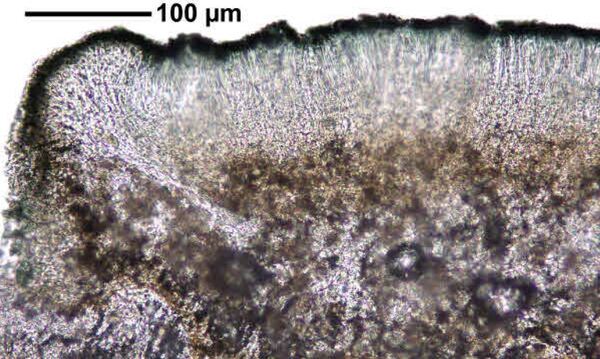

Felix Schumm – CC BY-SA 4.0
[10126], Südspanien, Prov. Granada: verbreitet auf glattem, schwach geneigtem, licht- und windoffenem Urgesteinsschutt im Omphalodinion rubinae (Frey) Follm., 3100 m, NW-SW, pH 6.5, Plattenschüsse am Nordwestaufschwung des Mulhacén in der Sierra Nevada. Leg. G. Follmann 07.1975, det. Poelt 09.1975.
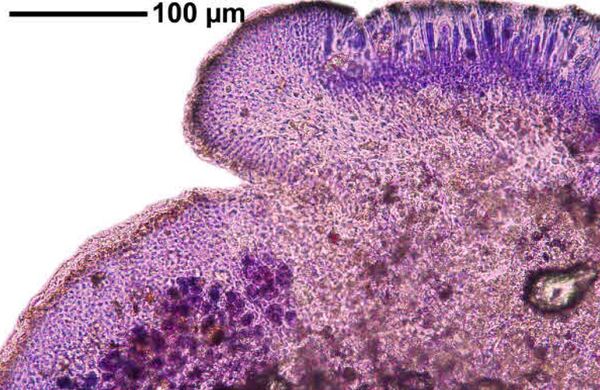

Felix Schumm – CC BY-SA 4.0
[10126], Südspanien, Prov. Granada: verbreitet auf glattem, schwach geneigtem, licht- und windoffenem Urgesteinsschutt im Omphalodinion rubinae (Frey) Follm., 3100 m, NW-SW, pH 6.5, Plattenschüsse am Nordwestaufschwung des Mulhacén in der Sierra Nevada. Leg. G. Follmann 07.1975, det. Poelt 09.1975.
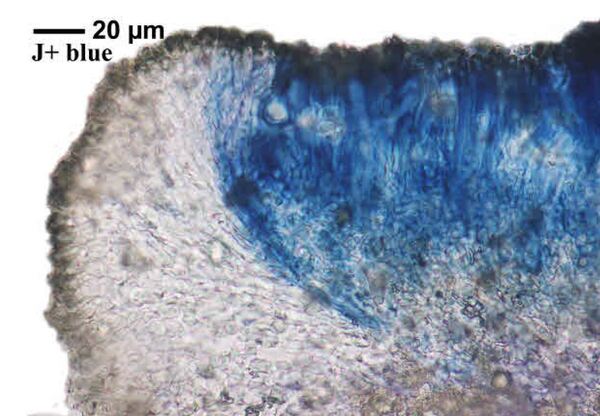

Felix Schumm – CC BY-SA 4.0
[10126], Südspanien, Prov. Granada: verbreitet auf glattem, schwach geneigtem, licht- und windoffenem Urgesteinsschutt im Omphalodinion rubinae (Frey) Follm., 3100 m, NW-SW, pH 6.5, Plattenschüsse am Nordwestaufschwung des Mulhacén in der Sierra Nevada. Leg. G. Follmann 07.1975, det. Poelt 09.1975.
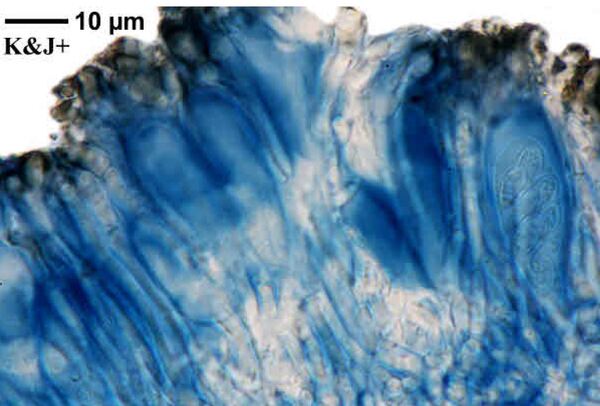

Felix Schumm – CC BY-SA 4.0
[10126], Südspanien, Prov. Granada: verbreitet auf glattem, schwach geneigtem, licht- und windoffenem Urgesteinsschutt im Omphalodinion rubinae (Frey) Follm., 3100 m, NW-SW, pH 6.5, Plattenschüsse am Nordwestaufschwung des Mulhacén in der Sierra Nevada. Leg. G. Follmann 07.1975, det. Poelt 09.1975.
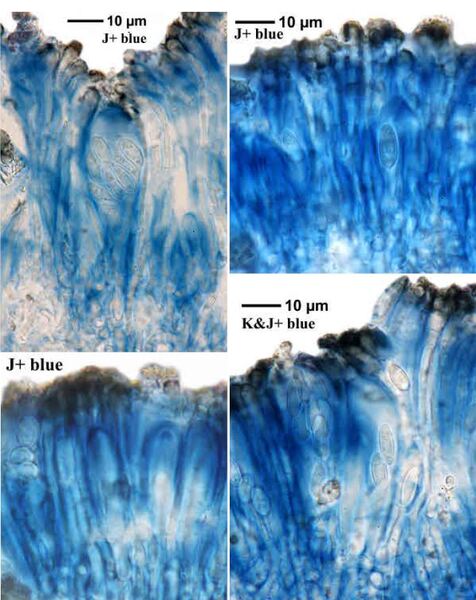

Felix Schumm – CC BY-SA 4.0
[10126], Südspanien, Prov. Granada: verbreitet auf glattem, schwach geneigtem, licht- und windoffenem Urgesteinsschutt im Omphalodinion rubinae (Frey) Follm., 3100 m, NW-SW, pH 6.5, Plattenschüsse am Nordwestaufschwung des Mulhacén in der Sierra Nevada. Leg. G. Follmann 07.1975, det. Poelt 09.1975.
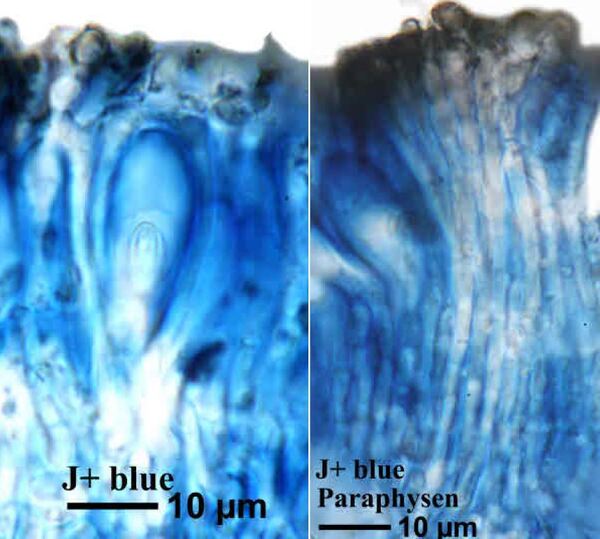

Felix Schumm – CC BY-SA 4.0
[10126], Südspanien, Prov. Granada: verbreitet auf glattem, schwach geneigtem, licht- und windoffenem Urgesteinsschutt im Omphalodinion rubinae (Frey) Follm., 3100 m, NW-SW, pH 6.5, Plattenschüsse am Nordwestaufschwung des Mulhacén in der Sierra Nevada. Leg. G. Follmann 07.1975, det. Poelt 09.1975.
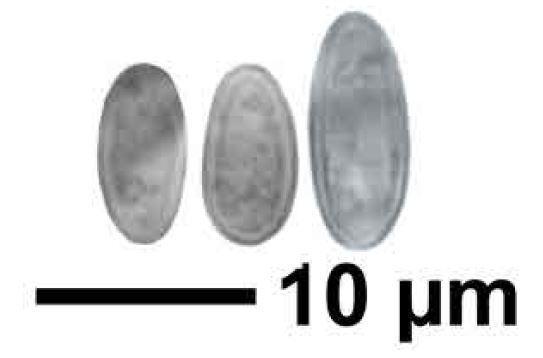

Felix Schumm – CC BY-SA 4.0
[10126], Südspanien, Prov. Granada: verbreitet auf glattem, schwach geneigtem, licht- und windoffenem Urgesteinsschutt im Omphalodinion rubinae (Frey) Follm., 3100 m, NW-SW, pH 6.5, Plattenschüsse am Nordwestaufschwung des Mulhacén in der Sierra Nevada. Leg. G. Follmann 07.1975, det. Poelt 09.1975.
Growth form: Crustose
Substrata: rocks
Photobiont: green algae other than Trentepohlia
Reproductive strategy: mainly sexual
paras Bellemerea spp. and Lecidea silacea when young
Species of metal-rich rocks
Commonnes-rarity: (info)
Alpine belt: extremely common
Subalpine belt: rather common
Oromediterranean belt: very rare
Montane belt: absent
Submediterranean belt: absent
Padanian area: absent
Humid submediterranean belt: absent
Humid mediterranean belt: absent
Dry mediterranean belt: absent

Predictive model
| Herbarium samples |


P.L. Nimis; Owner: Department of Life Sciences, University of Trieste
Herbarium: TSB (35206)
2002/07/09
marginal areolae and prothallus


P.L. Nimis; Owner: Department of Life Sciences, University of Trieste
Herbarium: TSB (11714)
2001/11/26


Felix Schumm – CC BY-SA 4.0
[10126], Südspanien, Prov. Granada: verbreitet auf glattem, schwach geneigtem, licht- und windoffenem Urgesteinsschutt im Omphalodinion rubinae (Frey) Follm., 3100 m, NW-SW, pH 6.5, Plattenschüsse am Nordwestaufschwung des Mulhacén in der Sierra Nevada. Leg. G. Follmann 07.1975, det. Poelt 09.1975.


Felix Schumm – CC BY-SA 4.0
[10126], Südspanien, Prov. Granada: verbreitet auf glattem, schwach geneigtem, licht- und windoffenem Urgesteinsschutt im Omphalodinion rubinae (Frey) Follm., 3100 m, NW-SW, pH 6.5, Plattenschüsse am Nordwestaufschwung des Mulhacén in der Sierra Nevada. Leg. G. Follmann 07.1975, det. Poelt 09.1975.


Felix Schumm – CC BY-SA 4.0
[10126], Südspanien, Prov. Granada: verbreitet auf glattem, schwach geneigtem, licht- und windoffenem Urgesteinsschutt im Omphalodinion rubinae (Frey) Follm., 3100 m, NW-SW, pH 6.5, Plattenschüsse am Nordwestaufschwung des Mulhacén in der Sierra Nevada. Leg. G. Follmann 07.1975, det. Poelt 09.1975.


Felix Schumm – CC BY-SA 4.0
[10126], Südspanien, Prov. Granada: verbreitet auf glattem, schwach geneigtem, licht- und windoffenem Urgesteinsschutt im Omphalodinion rubinae (Frey) Follm., 3100 m, NW-SW, pH 6.5, Plattenschüsse am Nordwestaufschwung des Mulhacén in der Sierra Nevada. Leg. G. Follmann 07.1975, det. Poelt 09.1975.


Felix Schumm – CC BY-SA 4.0
[10126], Südspanien, Prov. Granada: verbreitet auf glattem, schwach geneigtem, licht- und windoffenem Urgesteinsschutt im Omphalodinion rubinae (Frey) Follm., 3100 m, NW-SW, pH 6.5, Plattenschüsse am Nordwestaufschwung des Mulhacén in der Sierra Nevada. Leg. G. Follmann 07.1975, det. Poelt 09.1975.


Felix Schumm – CC BY-SA 4.0
[10126], Südspanien, Prov. Granada: verbreitet auf glattem, schwach geneigtem, licht- und windoffenem Urgesteinsschutt im Omphalodinion rubinae (Frey) Follm., 3100 m, NW-SW, pH 6.5, Plattenschüsse am Nordwestaufschwung des Mulhacén in der Sierra Nevada. Leg. G. Follmann 07.1975, det. Poelt 09.1975.


Felix Schumm – CC BY-SA 4.0
[10126], Südspanien, Prov. Granada: verbreitet auf glattem, schwach geneigtem, licht- und windoffenem Urgesteinsschutt im Omphalodinion rubinae (Frey) Follm., 3100 m, NW-SW, pH 6.5, Plattenschüsse am Nordwestaufschwung des Mulhacén in der Sierra Nevada. Leg. G. Follmann 07.1975, det. Poelt 09.1975.


Felix Schumm – CC BY-SA 4.0
[10126], Südspanien, Prov. Granada: verbreitet auf glattem, schwach geneigtem, licht- und windoffenem Urgesteinsschutt im Omphalodinion rubinae (Frey) Follm., 3100 m, NW-SW, pH 6.5, Plattenschüsse am Nordwestaufschwung des Mulhacén in der Sierra Nevada. Leg. G. Follmann 07.1975, det. Poelt 09.1975.


Felix Schumm – CC BY-SA 4.0
[10126], Südspanien, Prov. Granada: verbreitet auf glattem, schwach geneigtem, licht- und windoffenem Urgesteinsschutt im Omphalodinion rubinae (Frey) Follm., 3100 m, NW-SW, pH 6.5, Plattenschüsse am Nordwestaufschwung des Mulhacén in der Sierra Nevada. Leg. G. Follmann 07.1975, det. Poelt 09.1975.


 Index Fungorum
Index Fungorum
 GBIF
GBIF

